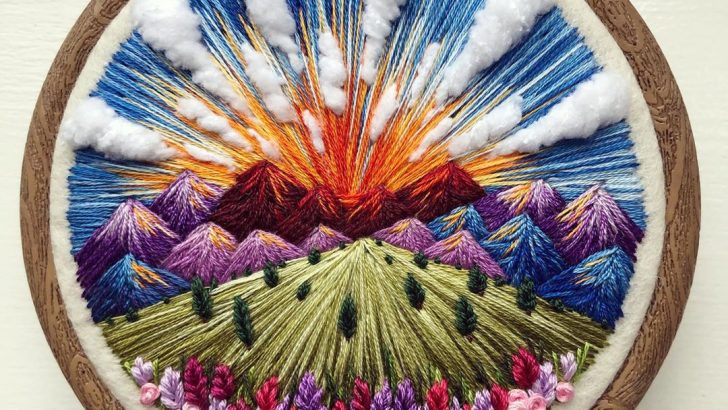Thick fabric embroidery techniques have gained popularity among crafters and designers looking to create unique, eye-catching pieces that stand out from traditional embroidery. Whether you’re working with denim, leather, or heavy canvas, these methods allow for intricate detailing and a tactile quality that adds depth and dimension to your work. The key to mastering thick fabric embroidery lies in understanding the right tools, materials, and stitching techniques that complement the texture and weight of the fabric. By exploring various approaches, you can unlock new creative possibilities and elevate your embroidery projects to a whole new level.
Choosing the Right Materials for Thick Fabric Embroidery
The foundation of any successful embroidery project starts with selecting the appropriate materials. When working with thick fabrics like denim, burlap, or leather, standard embroidery threads may not provide the necessary durability or visibility. Instead, opt for heavier-duty embroidery floss, such as 3-ply or 6-ply cotton, which offers more strength and vibrancy. For even greater impact, consider using metallic or variegated threads that catch the light and add a luxurious feel to your design.
In addition to thread, the choice of needles is crucial. A sharp, size 70/10 or 80/12 needle is ideal for piercing through thick layers without causing damage to the fabric. If you’re working with leather, a leather-specific needle with a pointed tip will help prevent splitting. For stabilizers, use a medium-weight cutaway or tearaway stabilizer to support the fabric and prevent puckering during stitching. These materials ensure that your embroidery remains secure and visually striking, even on the thickest of textiles.
Mastering Stiching Techniques for Thick Fabrics
Once you have the right materials, it’s time to focus on the actual stitching techniques. One popular method for thick fabrics is the backstitch, which creates a strong, continuous line that holds up well against wear and tear. This technique is especially effective for outlining shapes or adding fine details to your design. Another useful approach is the satin stitch, which fills in large areas with smooth, even stitches. To achieve the best results, use a small needle and tight spacing between stitches, ensuring that the fabric doesn’t pucker.
For added texture, try using the French knot or bullion knot. These techniques create raised, three-dimensional elements that give your embroidery a rich, layered look. They are particularly well-suited for floral patterns or decorative accents. Additionally, experimenting with different stitch combinations can lead to unexpected and beautiful results. For example, pairing straight stitches with chain stitches can add movement and visual interest to your piece.
Incorporating Color and Pattern for Visual Impact
Color plays a vital role in thick fabric embroidery, as it can dramatically influence the overall aesthetic of your design. When working with bold fabrics, consider using contrasting colors to make your embroidery stand out. For instance, a bright red thread on dark denim can create a striking contrast that draws attention to your work. On the other hand, using complementary colors can produce a more harmonious and sophisticated look.
Pattern selection is equally important. Simple geometric shapes, intricate lace-like motifs, or abstract designs can all be adapted to suit thick fabrics. It’s also helpful to sketch your design onto the fabric before starting to ensure proper placement and scale. Using a transfer pen or carbon paper can make this process easier, allowing you to maintain precision while working on textured surfaces.
Enhancing Your Work with Additional Textures
To take your thick fabric embroidery to the next level, consider incorporating additional textures and materials. Adding beads, sequins, or ribbons can introduce a new dimension to your design, making it more dynamic and visually engaging. These elements can be sewn directly onto the fabric using a needle and thread, or they can be attached with a small amount of adhesive for added security.
Another way to enhance your work is by layering different types of embroidery. For example, combining surface embroidery with cutwork or appliqué can create a multi-layered effect that adds depth and complexity. This technique is especially effective when working with heavy fabrics, as it allows you to build up the design gradually without overwhelming the material.
Tips for Successful Thick Fabric Embroidery Projects
Finally, there are several tips that can help you achieve better results when working with thick fabrics. First, always test your stitches on a scrap piece of fabric before beginning your main project. This allows you to adjust your tension and needle size as needed. Second, keep your workspace organized to avoid tangling your threads or losing small tools. Lastly, don’t be afraid to experiment with different techniques and materials—each project offers a new opportunity to learn and grow as an embroiderer.
By following these guidelines and embracing the unique challenges of thick fabric embroidery, you can create stunning designs that showcase your skill and creativity. Whether you’re making personalized gifts, fashion accessories, or home decor, the possibilities are endless. With practice and patience, you’ll soon be able to produce intricate, high-quality embroidery that truly stands out.
